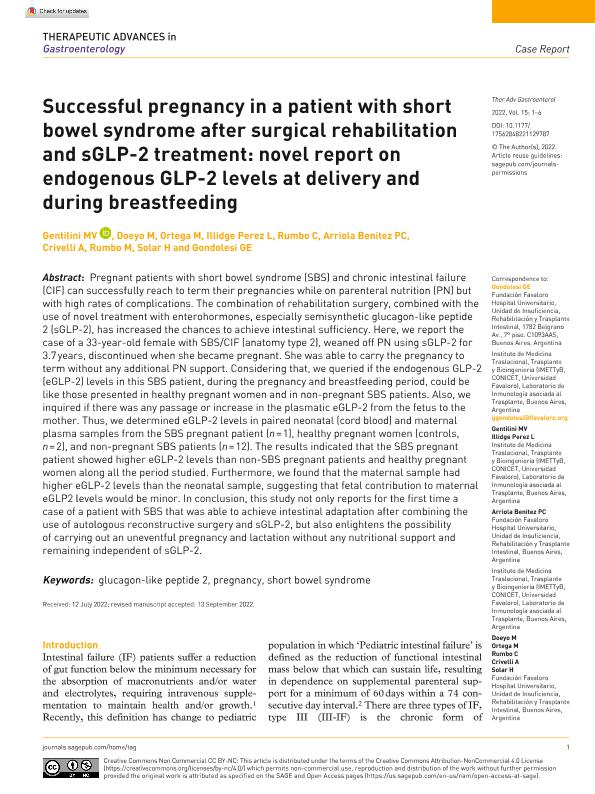Mostrar el registro sencillo del ítem
dc.contributor.author
Gentilini, Maria Virginia

dc.contributor.author
Doeyo, M.
dc.contributor.author
Ortega, M.
dc.contributor.author
Illidge Perez, L.
dc.contributor.author
Rumbo, C.
dc.contributor.author
Arriola Benitez, Paula Constanza

dc.contributor.author
Crivelli, A.
dc.contributor.author
Rumbo, Martín

dc.contributor.author
Solar, H.
dc.contributor.author
Gondolesi, Gabriel Eduardo

dc.date.available
2023-09-27T10:18:00Z
dc.date.issued
2022-11
dc.identifier.citation
Gentilini, Maria Virginia; Doeyo, M.; Ortega, M.; Illidge Perez, L.; Rumbo, C.; et al.; Successful pregnancy in a patient with short bowel syndrome after surgical rehabilitation and sGLP-2 treatment: novel report on endogenous GLP-2 levels at delivery and during breastfeeding; SAGE Publications; Therapeutic Advances in Gastroenterology; 15; 11-2022; 1-6
dc.identifier.issn
1756-2848
dc.identifier.uri
http://hdl.handle.net/11336/213164
dc.description.abstract
Pregnant patients with short bowel syndrome (SBS) and chronic intestinal failure (CIF) can successfully reach to term their pregnancies while on parenteral nutrition (PN) but with high rates of complications. The combination of rehabilitation surgery, combined with the use of novel treatment with enterohormones, especially semisynthetic glucagon-like peptide 2 (sGLP-2), has increased the chances to achieve intestinal sufficiency. Here, we report the case of a 33-year-old female with SBS/CIF (anatomy type 2), weaned off PN using sGLP-2 for 3.7 years, discontinued when she became pregnant. She was able to carry the pregnancy to term without any additional PN support. Considering that, we queried if the endogenous GLP-2 (eGLP-2) levels in this SBS patient, during the pregnancy and breastfeeding period, could be like those presented in healthy pregnant women and in non-pregnant SBS patients. Also, we inquired if there was any passage or increase in the plasmatic eGLP-2 from the fetus to the mother. Thus, we determined eGLP-2 levels in paired neonatal (cord blood) and maternal plasma samples from the SBS pregnant patient (n = 1), healthy pregnant women (controls, n = 2), and non-pregnant SBS patients (n = 12). The results indicated that the SBS pregnant patient showed higher eGLP-2 levels than non-SBS pregnant patients and healthy pregnant women along all the period studied. Furthermore, we found that the maternal sample had higher eGLP-2 levels than the neonatal sample, suggesting that fetal contribution to maternal eGLP2 levels would be minor. In conclusion, this study not only reports for the first time a case of a patient with SBS that was able to achieve intestinal adaptation after combining the use of autologous reconstructive surgery and sGLP-2, but also enlightens the possibility of carrying out an uneventful pregnancy and lactation without any nutritional support and remaining independent of sGLP-2.
dc.format
application/pdf
dc.language.iso
eng
dc.publisher
SAGE Publications

dc.rights
info:eu-repo/semantics/openAccess
dc.rights.uri
https://creativecommons.org/licenses/by-nc/2.5/ar/
dc.subject
GLUCAGON-LIKE PEPTIDE 2
dc.subject
PREGNANCY
dc.subject
SHORT BOWEL SYNDROME
dc.subject.classification
Otras Ciencias de la Salud

dc.subject.classification
Ciencias de la Salud

dc.subject.classification
CIENCIAS MÉDICAS Y DE LA SALUD

dc.title
Successful pregnancy in a patient with short bowel syndrome after surgical rehabilitation and sGLP-2 treatment: novel report on endogenous GLP-2 levels at delivery and during breastfeeding
dc.type
info:eu-repo/semantics/article
dc.type
info:ar-repo/semantics/artículo
dc.type
info:eu-repo/semantics/publishedVersion
dc.date.updated
2023-07-07T18:07:09Z
dc.journal.volume
15
dc.journal.pagination
1-6
dc.journal.pais
Reino Unido

dc.description.fil
Fil: Gentilini, Maria Virginia. Consejo Nacional de Investigaciones Científicas y Técnicas. Oficina de Coordinación Administrativa Houssay. Instituto de Medicina Traslacional, Trasplante y Bioingeniería. Fundación Favaloro. Instituto de Medicina Traslacional, Trasplante y Bioingeniería; Argentina
dc.description.fil
Fil: Doeyo, M.. Fundación Favaloro; Argentina
dc.description.fil
Fil: Ortega, M.. Fundación Favaloro; Argentina
dc.description.fil
Fil: Illidge Perez, L.. Fundación Favaloro; Argentina
dc.description.fil
Fil: Rumbo, C.. Fundación Favaloro; Argentina
dc.description.fil
Fil: Arriola Benitez, Paula Constanza. Consejo Nacional de Investigaciones Científicas y Técnicas. Oficina de Coordinación Administrativa Houssay. Instituto de Medicina Traslacional, Trasplante y Bioingeniería. Fundación Favaloro. Instituto de Medicina Traslacional, Trasplante y Bioingeniería; Argentina
dc.description.fil
Fil: Crivelli, A.. Fundación Favaloro; Argentina
dc.description.fil
Fil: Rumbo, Martín. Consejo Nacional de Investigaciones Científicas y Técnicas. Centro Científico Tecnológico Conicet - La Plata. Instituto de Estudios Inmunológicos y Fisiopatológicos. Universidad Nacional de La Plata. Facultad de Ciencias Exactas. Instituto de Estudios Inmunológicos y Fisiopatológicos; Argentina
dc.description.fil
Fil: Solar, H.. Fundación Favaloro; Argentina
dc.description.fil
Fil: Gondolesi, Gabriel Eduardo. Consejo Nacional de Investigaciones Científicas y Técnicas. Oficina de Coordinación Administrativa Houssay. Instituto de Medicina Traslacional, Trasplante y Bioingeniería. Fundación Favaloro. Instituto de Medicina Traslacional, Trasplante y Bioingeniería; Argentina
dc.journal.title
Therapeutic Advances in Gastroenterology
dc.relation.alternativeid
info:eu-repo/semantics/altIdentifier/url/http://journals.sagepub.com/doi/10.1177/17562848221129787
dc.relation.alternativeid
info:eu-repo/semantics/altIdentifier/doi/http://dx.doi.org/10.1177/17562848221129787
Archivos asociados
